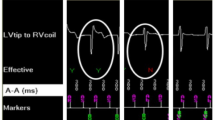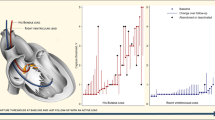Summary
VDD- and DDD-systems, as therapeutic options for high degree AV-block, are compared regarding the following criteria: implantation and complications, reliability of atrial sensing, survival of AV-synchronous stimulation, need for atrial stimulation, incidence of atrial arrhythmias and pacemaker follow-up.
VDD-systems are superior with respect to the implantation procedure, as implantation time is shortened by about 25% and fluoroscopy time is reduced by 42 to 59%. Beside this there is a trend towards a reduction of complications, as compared to DDD-implantation. Ventricular stimulation characteristics are similar in both systems. Comparable results for VDD- and DDD-systems have been demonstrated for the reliability of atrial sensing and for the survival of AV-synchronous stimulation, being above 90% after follow-up times of up to 6 years. Atrial stimulation is not necessary unless a symptomatic sinus node disease develops, which is a rare event (0–2%) in patients with underlying AV-block. The sinus node function can be assessed prior to implantation with easily obtainable parameters. Speculations whether VDD-stimulation might reduce the incidence of atrial fibrillation remain unproven. Pacemaker follow-up procedures are nearly similar for both systems.
Single-lead VDD stimulation is an alternative to DDD-stimulation in the treatment of patients with high degree AV-block. Published data show comparable results for both systems with some advantages for VDD-pacing.
Zusammenfassung
VDD- und DDD-Systeme in der Therapie des isolierten AV-Blocks werden anhand der Kriterien Implantation und Komplikationen, Sicherheit der atrialen Wahrnehmung, Erhalt der AV-synchronen Stimulation, Notwendigkeit einer atrialen Stimulation, Inzidenz atrialer Rhythmusstörungen und Schrittmachernachsorge gegenübergestellt.
VDD-Systeme sind bei der Implantation überlegen und zeigen einen Trend zur Verringerung von Komplikationen. Die ventrikulären Stimulationseigenschaften zeigen keine Unterschiede zwischen beiden Systemen. Bezüglich der Sicherheit der atrialen Wahrnehmung und dem Erhalt der AV-Synchronität sind für beide Schrittmachersysteme vergleichbare Ergebnisse dokumentiert. Die fehlende atriale Stimulationsmöglichkeit der VDD-Schrittmacher spielt nur dann eine Rolle, wenn eine stimulationsbedürftige Sinusknotenerkrankung auftritt. Dies ist bei Patienten mit zugrundeliegendem AV-Block selten. Die Beurteilung der Sinusknotenfunktion vor einer geplanten VDD-Implantation erscheint anhand einfacher Parameter möglich.
Als möglicher Vorteil der VDD-Schrittmacher wird eine geringere Häufigkeit von neu auftretendem Vorhofflimmern diskutiert, dies bleibt aber zum jetzigen Zeitpunkt spekulativ.
Bei der Schrittmachernachsorge sind beide Systeme vergleichbar.
VDD-Systeme stellen somit eine Alternative zu DDD-Systemen bei Patienten mit AV-Block dar. Nach den vorliegenden Daten sind sie DDD-Systemen sicher ebenbürtig, in einigen Aspekten sogar überlegen.
Similar content being viewed by others
Author information
Authors and Affiliations
Additional information
Eingegangen: 10. Juli 1998 Akzeptiert nach Revision: 7.Mai 1999
Rights and permissions
About this article
Cite this article
Nowak, B., Voigtländer, T. & Meyer, J. Single-lead VDD-Systeme: Eine Alternative zu DDD-Systemen bei Patienten mit AV-Block. Herzschr Elektrophys 10, 154–163 (1999). https://doi.org/10.1007/s003990050057
Issue Date:
DOI: https://doi.org/10.1007/s003990050057




